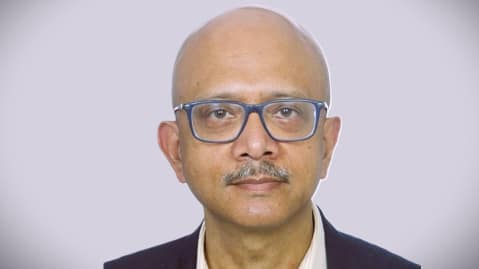In 2023, Azure Power was in crisis—$1.4 billion in debt, NYSE delisting, stalled audits (of FY22) and governance issues. Amid the crisis, a management overhaul became essential and Sugata Sircar stepped in as CFO to lead the turnaround. His first step: going back to basics.

Sugata Sircar, Group CFO and Executive Director of Azure Power
Before stepping in as Group CFO and Executive Director of Azure Power in May 2023, Sugata Sircar was comfortably on track for his next pivot. He had exited his role as CFO, Greater India at Schneider Electric with less than two years to go, pivoting into transformation advisory and board roles.
One such role was on Mauritius-based Azure Power’s board as an independent director. But what he witnessed from the board seat – a company in the throes of governance concerns, whistleblower allegations, rating downgrades, and stalled audits – compelled him to make a deeper commitment.
At the time, Azure was navigating one of the most turbulent phases in its corporate history. With about $1.4 billion in debt, two unresolved whistleblower complaints, a pending FY22 audit, delisting from the New York Stock Exchange (NYSE) in November 2023 and class action lawsuits hanging overhead, the company was in operational freeze.
Despite these challenges, Sircar saw a resilient foundation: $1.4 billion worth of operating assets across India, a healthy cash-generating business model, and long-term support from deep-pocketed institutional investors—Canada’s CDPQ (53.4%) and OMERS (21.1%). The company will soon be looking at funding primarily through domestic debt.
“It was a classic transformation opportunity,” Sircar recalls. “But it needed active stewardship, not passive oversight. I couldn’t do it as a non-executive director,” he added.
With board backing, he took charge as Executive Director and Group CFO, tasking himself with a multi-front revival—rebuilding financial credibility, resetting governance, restoring investor trust, and readying the business for a fresh phase of disciplined growth. The company is India’s first renewable energy firm and the first Indian company listed on the NYSE.
In this candid conversation with FE CFO, Sircar outlines the decisions taken in the past year to steer Azure Power out of crisis, and how he's laying the foundation for long-term resilience. Edited Excerpts.
Q: When you stepped in as Group CFO, Azure had just come through a difficult phase, including governance questions, whistleblower complaints, and rating downgrades, debt to be serviced. What were the first actions you took to start rebuilding trust with bondholders, investors, and regulators?
Restoring basic governance elements was key to unfreezing the company and restarting growth. Many of these are considered "basic hygiene" in large companies. But here, restoring those basics became critical to unfreezing the company. When you don’t have audited financials, investors get anxious. The system grinds to a halt.
One major milestone was clearing all delayed financials, which restored trust. With that done, we focused on our $1.4B debt portfolio—refinancing over $600M and bringing in new lenders, improving cost and flexibility.
Azure has had control systems in place but the governance framework needed an overhaul. We treated whistleblower complaints seriously, launched deep investigations, and tried to address every gap—be it people, processes, or accounting with transparency.
We rebuilt governance from the ground up: created a new Compliance & Ethics department, revamped SOPs, enterprise risk management, and control testing. But we also tackled mindset, driving engagement to embed accountability and integrity.
Financial reporting was a major issue. We committed to clearing financial backlogs—FY22 by Oct 2023, FY23 by March 2024, FY24 by July 2024—and met each of these timelines despite managing over 60 entities. Management reporting and budgeting was recreated with rigour.
We also embedded enterprise risk management rigorously, quarterly reviews with functional heads, identifying risk mitigation gaps, and tracking progress transparently. All this brought both internal clarity and external credibility.
Q: Was it a daunting task?
It was challenging. As there was interplay of people, process, culture and external factors, I figured that I had to run it like a project, identifying critical paths, dependabilities, etc.
We built back the teams, messaging continuously about collaboration and transparency. As we tried breaking silos and pushing people towards solution mode, some people excelled. We made clear targets and as we started achieving them, we could see the team getting energised.
While we had to navigate debacles along the way, achievement of milestones was the main energy booster.
Q: What was your approach with external stakeholders—bondholders, banks, regulators, analysts, investors—given the global investor base and NYSE delisting?
The pressure was high, especially with delayed financials and green bonds listed in Singapore. I personally met bondholders across key global hubs, was upfront about the issues, and committed to timelines. When we delivered starting with FY22 statements in October 2023 and then FY23 and FY24 statements, thereafter, it restored credibility.
Transparency was non-negotiable. We disclosed every allegation, action taken, and progress. There were audit qualifications on the effectiveness of controls in those years, which were removed in the financial statements for FY25, testifying the strengthening of governance.
At the end of the day, this is about authenticity and intent. One has to when you're honest, consistent, and transparent—even during tough times—it helps rebuild credibility over time.
We also had to engage very closely with auditors and rating agencies, providing them with full visibility and detailed disclosures. This wasn’t just a clean-up, it was a transformation. We re-established audit discipline, overhauled internal processes, and ensured there was no ambiguity around responsibilities.
Q: In FY25 report and found the level of transparency striking. For instance, under ‘financial risks’, you've openly disclosed that cash reserves and cash flows are insufficient to meet working capital and expansion plans. You've also stated the company has not been profitable in past fiscals and doesn’t expect to be profitable in the near future. These are significant disclosures. Could you help us understand them?
The disclosures on profitability and losses follow US GAAP reporting norms—they're standard and meant to ensure transparency. That said, we’ve taken a cautious stance,
The whistleblower-related disclosures are unique to Azure. Note 27 of the financials and the risk section details the allegations, investigations, and outcomes.
Q: Despite these risk disclosures, are you saying the core business remains strong and fundamentally profitable?
Yes. If you isolate the extraordinary items, the business is fundamentally profitable. There are a few unusual expenses that are distorting the picture at the P&L level.
First, there’s been exceptionally high legal expenditure due to multiple U.S.-based law firms involved in the whistle blower investigations, class action and related matters—this is not a recurring cost in a typical year.
Second, we had to take significant charges related to two legacy projects from 2020—a 2.3 GW and a 700 MW project. These were never started, and the Board, after thorough review, decided to surrender them in early 2024. That decision led to provisioning of bank guarantees issued to central agencies and other associated costs.
These provisions have been made in the last two years.
In the latest financials for the group for FY 2025, such unusual items would stack up to over $40 Mn, including the charge for settlement of a Class Action suit from 2022.
But underneath that, each of our project-level SPVs are financially healthy, generating returns and servicing debt. The business model remains sound and cash-generating.
Q: So how do you evaluate the current cash position of the company, especially from a growth versus operations standpoint?
Our current cash reserves are adequate to fund operational needs. What they may not support is aggressive growth, and that’s typical for the nature of our business—we need equity and debt to fund expansion. But we’re in a much stronger financial position today than a year ago.
Q: What would your advice be to budding CFOs or those who’ve just started sitting on the board?
Be transparent. Be authentic. But most importantly, listen carefully.
CFOs in board meetings have to listen, to understand the context of queries and comments. This helps in building trust with board members and a shared purpose.
This is a foundational element of a productive board-CFO relationship.
Q. As CFO today, how do you see the future of the company? What is the board and management mindset, and what is your focus?
The situation is stable now. Our immediate focus has been on restoring governance, transparency, and trust, while stabilising operations and charting a clear growth path. Shareholder representatives are closely involved, and the long-term outlook remains stable and encouraging.
One of our key strengths is a 3 GW portfolio spread across 31+ entities and numerous solar plants. We're prioritising performance enhancement of these assets, backed by global benchmarking and technical expertise from our shareholders.
We're also focused on cost optimisation—reassessing our cost structure, and leveraging automation and digital tools to improve efficiency and lower O&M costs.
Then there’s the pipeline of new projects. Right now, we have about 967 Megawatts in the pipeline where Letters of Award (LoAs) have already been signed. These may move to the Power Purchase Agreement (PPA) stage in tranches as and when SECI finds discoms to sign Power Sale Agreements (PSAs). One tranche of about 300 Megawatt may move to the PPA stage soon.
Earlier, Azure would win bids before securing land and grid connectivity. We have flipped the approach—applying for connectivity first. We've already secured 600 MW of new connectivity and applied for another 600 MW.
The group is focused on asset performance and on assessment of development opportunities, among other things.
By continuing you agree to our Privacy Policy & Terms & Conditions
